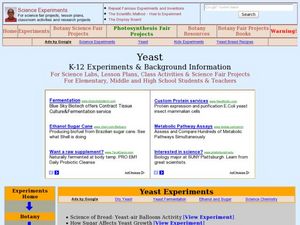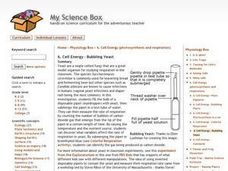Curated OER
The Energy Debate - Energy of Peanut
Students articulate the difference between the terms heat and temperature. They calculate the amount of energy associated with a given temperature rise and design an experiment to measure the energy of a fuel.
Curated OER
Energy and Changes of State
Students complete a variety of labs to help them explain how energy affects the changes in states of matter. They also be required to collect and record data, graph data, and apply interpretations of that data.
Curated OER
Phase Change
Learners compare the freezing temperature of two substances by conducting an experiment to freeze liquid ice cream. They vary the amount of salt used in the ice cubes during the freezing procedure to determine the change in the...
Curated OER
Foods II Introductory Review Practical Test
Students have a lab experience preparing a recipe demonstrating the techniques learned from Foods I. They identify and explain the appropriate use and care of basic kitchen equipment. They apply the skills and techniques of proper...
Curated OER
Chemquest: Physical Changes or Chemical Reactions
Students explore physical and chemical changes. In this chemistry lesson plan, students will go outside to observe changes seen in nature. Students will then work in the lab to identify changes at different stations prior to doing a...
Curated OER
What's in the Water?
Students make a water sampler and use proper techniques to collect water.They write a essay explaining the inter-relationship of factors such as temperature, pH, dissolved oxygen, nitrates, and phosphates in a lake that might cause a...
Curated OER
Plant Transpiration
Students conduct various experiments to investigate plant transpiration. In this biology lesson, students explain how this process helps maintain the hydrologic cycle. They measure the rate of water loss in plants using a potometer.
Curated OER
Yeast
Students study the characteristics of yeasts. In this biology lesson, students conduct experiments to measure yeast respiration. They discuss the favorable conditions needed for growing them.
Curated OER
An Introduction to Sensors
Students research the International System (SI) of units of measurements. They make measurements using the metric system. They study key concepts used in building and use of sensors, how sensors work and their role in measuring...
Curated OER
Enzymatic Action
Students observe how a cell uses an enzyme to rid itself of a poisonous substance by experimenting with hydrogen peroxide, potatoes, liver and carrots. They record the temperature and changes of the hydrogen peroxide as other elements...
Curated OER
Cell Energy - Bubbling Yeast
Students identify that yeast are a single celled fungi that are a great model organism for studying respiration in the classroom. They also fill the bulb of a disposable pipet (eyedropper) with yeast, then submerge the pipet in a test...
Curated OER
Let's Make a Compost Cake
Students create a compost cake. In this gardening and decomposition science instructional activity, students review and describe the "nutrient cycle." Students create a compost pile, measure and record the dimensions and temperature of...
Curated OER
The History of Climate Change
In this science worksheet, young scholars gather in-depth information dealing with climate change over the next century. They analyze the grid to determine the average time difference between peaks in the temperature history for the last...
Curated OER
Physical vs. Chemical Change Lab
Students recognize both a physical and chemical change in different substances. They determine which particles actually changed into different substances, and explain if it represented a physical or a chemical change.
Virginia Department of Education
Molar Heat of Fusion for Water
How can you describe heat of fusion in a way the class understands and relates the importance of this concept to present day issues? In this third lesson of the series, learners conduct an experiment, demonstrating the flow of heat...
Science 4 Inquiry
The Yin and Yang of Photosynthesis: Day vs. Night
Floating fragments of elodea can grow even without roots. Young scientists use eldoea plants to observe the oxygen production from photosynthesis. They study the difference between having access to high amounts of light and low amounts...
Curated OER
Carbon Dioxide Heats It Up
Students design an investigation to test whether vegetation in an area helps regulate the ambient air temperature. They make comparisons between the investigation and global changes in climate. In groups, they present their findings to...
Curated OER
Taking In The Heat
Students discover that different textured materials can absorb more heat than others. Students work with thermometers, clocks, and graphs.
Curated OER
Oxidation of Iron - An Example of a Combination Reaction
Here are photos and general instructions for demonstrating two oxidation reactions with your physical science beginners. They use salt and hydrogen peroxide to cause iron filings to rust, and they combine hydrogen peroxide with a piece...
Curated OER
Physics Post-Lab
Students explore physics. In this science lesson, students discuss physics in their everyday lives. Students complete a physics worksheet.
Curated OER
Water Density and Stability Lab
Students observe how different water densities and salinity control the depth at which different water masses occur. Submarines are used as a case study. This is a well-designed with an excellent worksheet.
Curated OER
Upwelling Terrestrial Radiation
Students calculate the hourly irradiance of the earth at a site given the near-surface air temperature of the site. They compare the calculated values of irradiance with those measured by instruments at the site. Students need to...
Curated OER
Heat Unit
Students define thermal equilibrium. They distinguish between internal energy and heat. Students describe how the quantity of heat that enters or leaves a substance is measured.
Curated OER
How Much Energy Does the Earth Receive from the Sun?
Students explore energy. In this science lesson, students conduct an experiment in which they measure how much energy is produced by the sun. Students build a calorimeter to measure the amount of energy.























